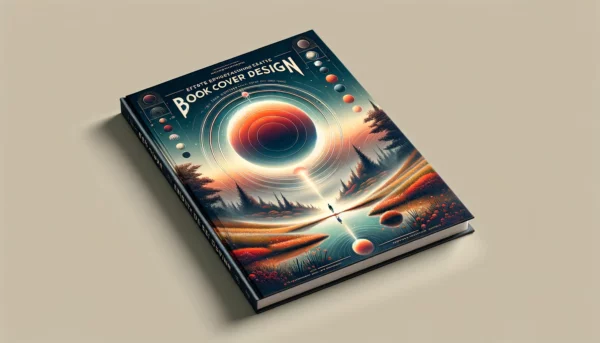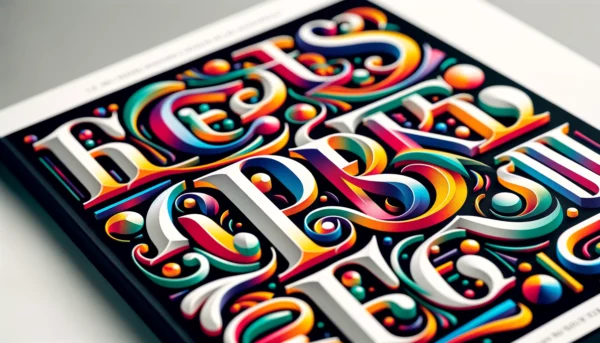In the realm of publishing, a good book cover design acts as a crucial interface between the written word and its potential audience, making book cover design an essential aspect of the industry. An effective book cover design not only captivates at first glance but also conveys the essence of the narrative within, making it a powerful marketing tool that can significantly influence a book’s commercial success.
In 2024, the book cover trends and cover design trends mirror broader cultural and technological shifts, blending bold typography, bold designs, vibrant colors, and digital innovations to reflect the publishing world’s adaptability and the evolving tastes of readers, highlighting the artistry and climate of our times.
This article explores the pivotal book cover design trends of 2024 in the publishing world, examining how aesthetic elements such as design styles and AI technology converge to captivate readers and reflect the current climate, offering insights into creating standout book covers in a competitive market.
The Evolution of Book Cover Design
The journey of book cover design has been one of constant evolution, mirroring shifts in artistic movements, technological advancements, and consumer tastes. Initially serving a purely protective function, book covers have transformed into vital storytelling tools and marketing assets. The advent of the 20th century saw book covers becoming canvases for artwork, with designers like Chip Kidd revolutionizing the way covers communicate a book’s essence. The digital age further accelerated changes, introducing graphic design software that expanded creative possibilities.
In the last few years alone, leading up to 2024, there has been a noticeable shift towards bold typography, minimalist designs, and the integration of digital art, reflecting the growing influence of online platforms and social media on consumer preferences. The resurgence of handcrafted elements and the trend towards retro-inspired cover designs also highlights a nostalgic yearning amidst digital saturation. Moreover, the rise of AI and machine learning has begun to shape cover aesthetics, with algorithms now capable of analyzing trends and generating designs. These developments signify not just changes in design techniques and styles but also a broader transformation in how books are marketed and consumed in the digital era.
Start Your Publishing Journey FOR FREECurrent Trends in Book Cover Design
In 2024, the landscape of book cover design is characterized by a diverse array of trends, each catering to the evolving preferences of readers and the dynamic nature of visual storytelling.
Bold Typography is at the forefront, with designers opting for large, impactful fonts that immediately draw the eye. This trend emphasizes the power of words, using scale and weight to convey the tone and essence of the book’s story throughout, ensuring the title makes a strong impression on potential readers.
Pop Art Influence infuses book covers with a burst of energy and color, drawing inspiration from this iconic pop art movement. The use of bold graphics, vivid colors, and stylized imagery creates covers that are not only eye-catching but also resonate with a sense of fun and dynamism, appealing to a wide audience.
Minimalistic Designs represent a shift in style towards simplicity and clarity. By focusing on one or two key design elements and stripping away the unnecessary, these covers offer a breath of fresh air, embodying the adage that less is more. This design trend speaks to a desire for calm and uncluttered visual experiences in a busy world.
Retro and Vintage Elements bring a touch of nostalgia to book covers, connecting readers with the past through the use of retro elements and designs that evoke emotions and recall earlier decades. Whether through typography, color palettes, or imagery, these covers evoke a sense of familiarity and comfort, appealing to the sentimental value of bygone eras.
Real-life photography sees book covers utilizing photographs and illustrations that directly relate to the book’s content, main character, or themes. This approach lends an air of authenticity and immediacy to the cover, allowing potential readers to glimpse the world within the pages before even opening the book.
Bold Contrasts and Vibrant Colors create covers that stand out on the shelves. High contrast color schemes and saturated hues demand attention, making the book visually compelling and hard to overlook in a crowded bookstore.
Futuristic and Sci-Fi Themes cater to the growing interest in science fiction and speculative genres. Covers in this category often feature futuristic motifs, otherworldly landscapes, futuristic designs, and advanced technological elements, setting the stage for the adventures within the pages.
Together, these trends paint a picture of a vibrant and eclectic book cover design scene in 2024, where creativity and innovation continue to push the boundaries of how stories are visually represented.
The Role of AI in Identifying and Creating Design Trends
The integration of Artificial Intelligence (AI) into the realm of book cover design marks a significant evolution in how book cover design trends are identified and implemented. AI tools, with their capacity to sift through vast datasets, have become instrumental in pinpointing emerging book cover design trends. By analyzing patterns in consumer behavior, social media, and current design portfolios, these tools offer predictive insights into what visual styles are gaining traction.
AI’s contribution extends beyond mere trend analysis; it actively aids designers in the creative process. Leveraging machine learning algorithms, AI can suggest innovative design elements and compositions that align with identified trends, effectively providing a creative partner that enhances a designer’s vision with data-driven suggestions. This collaboration allows for the exploration of novel concepts, ensuring that designs remain at the cutting edge of current aesthetics.
AI-Driven Companies and Platforms in Book Cover Design:
Trend Forecasting & Automated Design Generation: Pioneering companies utilizing AI to analyze design trends and generate creative concepts.
Canva & Adobe Spark: Utilize AI to streamline the design process, offering templates and design elements aligned with current trends.
Book Brush & RelayThat: Specializes in book cover design, providing AI-powered tools to help authors and designers craft compelling covers.
Spines: An AI-driven publishing house that streamlines the publishing process from book cover designs to marketing. They guide you through the book cover design process, using the magic of AI, to produce the best design for your book cover as well as the spine and back. Sign up for free to start creating your book cover.
Start Your Publishing Journey FOR FREEMoreover, AI holds the promise of hyper-customization. By understanding the preferences of specific target audiences or the nuances of different genres, AI can tailor book cover designs to appeal more directly to intended readers. This level of personalization ensures that each book cover will not only reflects the latest design trends but also speaks directly to the book’s potential audience, increasing its appeal and marketability.
Importance of Visual Elements in Conveying the Book’s Story
The visual elements of a book cover serve as a silent storyteller, subtly hinting at many elements of the narrative’s plot and establishing the story and tone for potential readers. Images in book cover design, whether illustrations or photographs, act as windows into the story’s world, offering glimpses of characters, settings, or pivotal moments. These visual cues engage the reader’s imagination, sparking curiosity and anticipation about the journey within the pages.
Patterns and textures add depth and context to this visual narrative. A floral pattern might hint at a romantic or historical theme, while geometric patterns and shapes could suggest a more modern or scientific style or storyline. These elements of style, though seemingly background, play a crucial role in setting the book’s mood and genre at first glance.
Color psychology is another powerful tool in a designer’s arsenal. Colors evoke specific emotions and associations—red can signify passion or danger, blue for calmness or sadness, white space for natural beauty, and yellow for happiness. The choice of color palette on a book cover can, therefore, profoundly affect a potential reader’s emotional response and interest in the book.
The cover’s overall composition—the interplay of images, patterns, and colors—creates a visual hierarchy that guides the viewer’s eye and emphasizes the most critical elements, usually the book title and author’s name. This orchestrated first impression and visual interest is pivotal in evoking emotions that resonate with the book’s content, setting the stage for the reader’s engagement. A well-designed cover not only intrigues but also promises a reading experience that aligns with the book’s plot and initial emotional and visual cues, making it a critical factor in allure and success.
Typography and Its Impact
Typography on a book cover does more than convey the book title and author’s name; it plays a pivotal role in setting the book’s tone and enhancing its visual appeal. The choice between serif and sans-serif fonts, for instance, can significantly influence the book’s cover’s overall feel. Serif fonts, with their decorative strokes, often evoke a sense of tradition and authority, making them a popular choice for historical novels, classic literature, and academic works. Sans-serif fonts, on the other hand, are prized for their clean, modern lines, lending a contemporary and approachable look ideal for young adult fiction, tech-related topics, and non-fiction.
- Size, Color, and Placement of Typography: Crucial for establishing the cover’s visual hierarchy and guiding focus to key information.
- Well-Designed Title: Strategic emphasis and placement enhance legibility and integrate with the other trends in the cover’s art, boosting the story and aesthetic appeal.
- Author’s Name Consideration: Though often secondary in the visual hierarchy, the author’s name requires careful positioning to ensure design balance and harmony with style and other elements throughout.
Target Audience and Genre Considerations
Book cover design intricately aligns with target audience preferences and genre specifics, playing a crucial role in appealing to potential readers. Genres dictate distinct design elements, from cozy mysteries’ warm hues and playful illustrations to non-fiction’s bold typography and factual visuals. Personal touches like handwritten fonts lend intimacy to memoirs, while bold contrasts in typography signal the gravity of more intense narratives. Understanding the target demographic, including age, gender, and cultural background, further refines book cover design trends and choices, ensuring that covers resonate with their intended audience.
For example, young adult novels might embrace vibrant colors and modern graphics, whereas historical or non-fiction books could favor muted tones and era-specific imagery. This nuanced approach ensures that a book’s cover connects with the reader and reflects the book’s content, enhancing the appeal and marketability.
Start Your Publishing Journey FOR FREEThe Role of Designers in Shaping Trends
Book cover designers play a crucial role in shaping trends, adeptly balancing the latest trends and design movements with an author’s unique voice and the narrative’s specific requirements. They engage in an exploration of the book’s core, extracting pivotal themes and motifs to translate them into visually compelling designs and illustrations. This process ensures that the cover resonates with potential readers, embodying the story and author’s style with a delicate mix of intuition, artistic skill, and an acute understanding of market dynamics.
Increasingly, this creative endeavor involves collaboration with AI tools, which provide data-driven insights and innovative suggestions for cover designs. This partnership enhances the designer’s capacity for innovation, blending human creativity with AI’s analytical prowess. The result is a cover that is not only visually appealing but also strategically positioned to align with emerging trends and reader preferences, ensuring the book’s prominence in a competitive market.
Future Direction of Book Cover Design Trends
The future of book cover design is poised at the exciting intersection of emerging technologies like AI and evolving cultural trends. AI’s growing sophistication could lead to more personalized, dynamic book covers, that adapt to individual preferences, while virtual and augmented reality might offer interactive experiences directly from the cover. Culturally, we may see a surge in book cover trends and designs that reflect global narratives and inclusivity, mirroring society’s expanding diversity. These advancements suggest a future where book covers not only captivate visually but also offer immersive experiences, deeply intertwined with the cultural and technological fabric of their times.
In summary, the landscape of book cover design in 2024 is marked by a rich tapestry of trends, from bold typography to AI-driven innovations, each reflecting the zeitgeist. The role of book cover designers has evolved, integrating AI tools to balance artistic vision with market demands, ensuring that covers attract attention. The future of book cover designs promises even greater integration of technology, potentially revolutionizing the interaction between book and reader. The enduring impact of these advancements lies in their ability to enhance the reading experience, underscoring the symbiotic relationship between creativity, technology, and the ever-dynamic publishing world.
Start Your Publishing Journey FOR FREE






